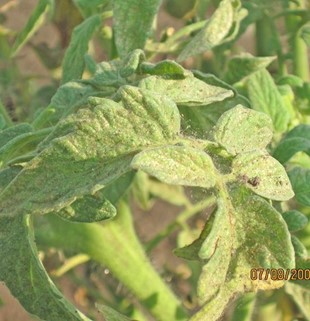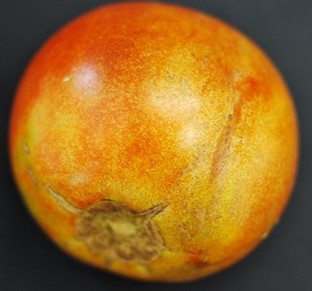Disease Notes
Contact
Plant Diagnostician
Phone: (479) 575-2727
Email: ssmith@uada.edu
Jason Pavel
Diagnostician
Phone: (479) 575-7257
Email: jpavel@uada.edu
University of Arkansas System Division of Agriculture
Cralley Warren Building
Room 16
2601 N. Young Ave.
Fayetteville, AR 72704
Tomato – Spider Mite Damage
by Sherrie Smith and Jason Pavel

Tomato Spider Mite Damage – Tetranychus spp.
Photo by Don Plunkett, University of Arkansas Cooperative Extension
Are spider mites attacking your tomato plants?
Spider mites attack many species of plants, including vegetables and ornamentals. Several species of spider mites attack tomatoes, notably Tetranychus urticae and T. evansii. Spider mites are typically found feeding and reproducing on the undersides of leaves. They are sap feeds, feeding off the contents of individual plant cells. Their feeding activity produces a white to yellow stippling across the surface of the plant tissues that eventually takes on a bronze appearance. Leaves become dry and brown. Heavy feeding on fruit causes yellowish speckling across the surface of the fruit.

Tomato Spider Mite Damage – Tetranychus spp.
Photo by Sherrie Smith University of Arkansas Cooperative Extension
Serious infestations can kill leaves and eventually the plant. In heavy infestations, small webs may be observed. It’s important to recognize the problem before leaves start dying. Commercial growers may use Agri-Mek 0.15 EC, Brigade 2 EC, Dicofol 4E, or Oberon 2 SC. Homeowners may use Malathion or insecticidal soaps. Depending on the product used, applications should be made every 2 to 3 days.
Take Aways
- Scout for evidence of mites every few days.
- Apply recommended products per label.
- Failure to reapply per label will limit success at mite control.
This work is supported by the Crop Protection and Pest Management Program [grant no. 2017-70006- 27279/project accession no. 1013890] from the USDA National Institute of Food and Agriculture.